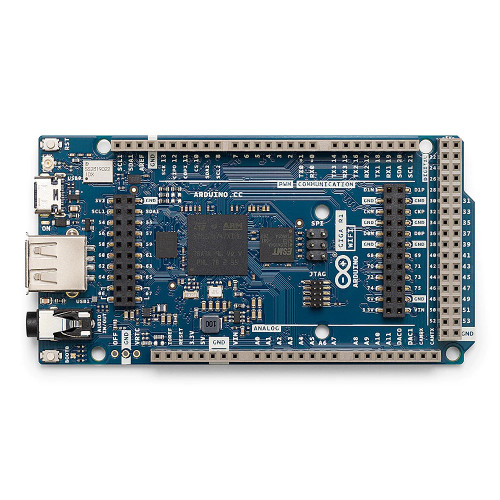
Arduino GIGA R1 WiFi | ABX00063
The Arduino GIGA R1 WiFi is designed for ambitious makers who want to step up their game. It levels the playing field for gamers, artists, sound designers, and anyone coming to the tech world with big ideas on a budget – because it packs advanced features into an accessible component, with the same form factor as our popular Mega and Due.
Let’s break down all the powerful features of this board.
Microcontroller (STM32H747XI): This dual-core 32-bit microcontroller allows you to have two brains talking to each other (a Cortex®-M7 at 480 MHz and a Cortex®-M4 at 240 MHz). You can even run MicroPython in one and Arduino in the other.
Wireless communication (Murata 1DX): Whether you prefer Wi-Fi® or Bluetooth®, the GIGA R1 WiFi has you covered. You can even quickly connect to the Arduino IoT Cloud and keep track of your project remotely. And if you are concerned about the security of the communication, the ATECC608A keeps everything under control.
Hardware ports and communication: Following the legacy of the Arduino Mega and the Arduino Due, the GIGA R1 WiFi has 4 UARTs (hardware serial ports), 3 I2C ports (1 more than its predecessors), 2 SPI ports (1 more than its predecessors), 1 FDCAN.
GPIOs and extra pins: The Arduino GIGA R1 WiFi keeps the familiar Mega and Due form factor, making it easy to adapt existing custom shields. It runs at 3.3V logic, and extra headers boost the total to 76 GPIO pins. These pins are also accessible from underneath the board, so you can expand your project without redesigning it. Two new pins add more flexibility: VRTC, for connecting a battery to keep the real-time clock active when the board is off, and OFF, to safely power down the board.
Connectors: The GIGA R1 WiFi has extra connectors on board, which will facilitate the creation of your project without any extra hardware. This board has:
- USB-A connector suitable for hosting USB sticks, other mass storage devices, and HID devices such as a keyboard or mouse.
- 3.5mm input-output jack connected to DAC0, DAC1, and A7.
- USB-C® to power and program the board, as well as simulate an HID device such as a mouse or keyboard.
- Jtag connector, 2x5 1.27mm.
- 20-pin Arducam camera connector.
Higher voltage support: In comparison with its predecessors that support up to 12 volts, the GIGA R1 WiFi can handle a range of 6 to 24 volts.
Tech specs
| Board | Name | Arduino® GIGA R1 WiFi |
| SKU | ABX00063 | |
| Microcontroller | STM32H747XI dual Cortex®-M7+M4 32bit low power Arm® MCU (datasheet) | |
| Radio Module | Murata 1DX dual WiFi 802.11b/g/n 65 Mbps and Bluetooth® (datasheet) | |
| Secure Element | ATECC608A-MAHDA-T (datasheet) | |
| USB | USB-C® | Programming Port / HID |
| USB-A | Host (enable with PA_15) | |
| Pins | Digital I/O Pins | 76 |
| Analog input pins | 12 | |
| DAC | 2 (DAC0/DAC1) | |
| PWM pins | 12 | |
| Misc | VRT & OFF pin | |
| Communication | UART | Yes, 4x |
| I2C | Yes, 3x | |
| SPI | Yes, 2x | |
| CAN | Yes (Requires an external transceiver) | |
| Connectors | Camera | I2C + D54-D67 |
| Display | D1N, D0N, D1P, D0P, CKN, CKP + D68-D75 | |
| Audio Jack | DAC0, DAC1, A7 | |
| Power | Circuit operating voltage | 3.3V |
| Input voltage (VIN) | 6-24V | |
| DC Current per I/O Pin | 8 mA | |
| Clock Speed | Cortex® M7 | 480 MHz |
| Cortex® M4 | 240 MHz | |
| Memory | STM32H747XI | 2MB Flash, 1MB RAM |
| Dimensions | Width | 53 mm |
| Length | 101 mm | |
Documentation
FAQs
Do I need an external antenna? Is it included?
Yes. The board has no onboard antenna, and a u.FL antenna is included in the box.
Which Arducam models work with the camera connector?
The 20-pin J6 camera adapter supports Arducam models such as OV7675 and OV7670. For setup, see the GIGA R1 WiFi Camera guide.
What’s the difference between Portenta H7 and GIGA R1 WiFi?
GIGA R1 WiFi uses USB-C for power, programming, and HID. Portenta H7 also supports DisplayPort out, USB hub, and OTG power. GIGA exposes 2.54 mm headers for prototyping and adds USB-A host, a 3.5 mm jack, and a JTAG connector.
Which shields are compatible with GIGA R1 WiFi?
Shields with UNO, Mega, or Due form factors that support 3.3 V logic are generally compatible. Always confirm with the shield manufacturer.
What’s the difference between the two USB connectors?
USB-C (USB0) is for programming, serial communication, and 5 V power. USB-A (USB1) is a USB host only and not a programming port.





